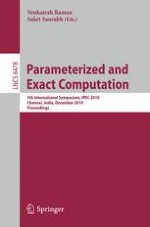2010 | Book
Parameterized and Exact Computation
5th International Symposium, IPEC 2010, Chennai, India, December 13-15, 2010. Proceedings
Editors: Venkatesh Raman, Saket Saurabh
Publisher: Springer Berlin Heidelberg
Book Series : Lecture Notes in Computer Science
